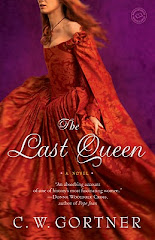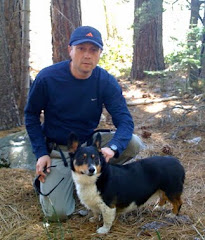I'm delighted to welcome Nancy Bilyeau, author of THE CROWN, which has just been released in paperback. This terrific novel about a nun who must abandon her cloister during Henry VIII's turbulent destruction of the monasteries to save her father and discover the truth about an ancient relic has garnered unanimous acclaim and was shortlisted for the prestigious Ellis Peters Award for Best Historical Crime Fiction. The novel's sequel, The Chalice, will be released next year.
Here, Nancy shares with us here her own initiation in Tudor mania, an obsession many of us know well. Please join me in welcoming her.
The Stages of Tudor Mania
People keep asking me why I chose to write a novel set in
16th century England. It’s not perhaps the most obvious source of inspiration.
I am an American, growing up in the Midwest and now living in New York City.
I’ve worked for magazines like InStyle and Rolling Stone and Ladies’ Home
Journal. I adore films and Italian food and ocean beaches. So why am I fixated
on a family that ruled England from 1485 to 1603?
I thought it was time to explain.
Launch pad: In the beginning, there were Keith Michell and Glenda
Jackson. I watched “The Six Wives of Henry VIII” and “Elizabeth R” on
television with my parents in Livonia, Michigan. I was fascinated by the vivid
drama of these personalities—the mercurial king, the jostling of the six wives,
the courage of Elizabeth.
For a while the stories of this period were everywhere: I
saw “Anne of a Thousand Days” and “Mary Queen of Scots” as a double feature in
the local cinema. Another classic that I saw on television was “A Man for All
Seasons.” But I longed for more of Vanessa Redgrave’s giggling Anne Boleyn—I
was just too young for Sir Thomas More’s wisdom, I’m afraid. I began checking out books from the library on the 16th
century. I remember a librarian didn’t want me to have a book about the divorce
of Catherine of Aragon because it had the word “divorce” in the title and she
thought I was too young.
The middle years: Through high school, college and my 20s
and 30s, my interest did not wane. I read nonfiction about the 16th century,
such as J.J. Scarisbrick’s Henry VIII, Retha Warnicke’s The Rise and Fall of
Anne Boleyn, and Antonia Fraser’s Mary Queen of Scots. I read deeply in
historical fiction too, not just stories of the Tudors by authors like Jean
Plaidy but Mary Stewart’s Merlin trilogy and Anya Seton’s Katherine. My
favorite of all was Norah Lofts, and I marveled at her ability to write about
women ranging from Eleanor of Aquitaine to Hortense de Beauharnais. I read
everything I could find by Daphne du Maurier, novels and short stories too. I
loved her historical fiction such as Jamaica Inn but I also reveled in her use
of suspense.
 The crescendo: When I joined a fiction workshop in 2006, I
announced that I wished to set my mystery novel in the 16th century. I wanted
to unite my two passions: Tudor history and mystery thrillers. Thanks to the
success of Philippa Gregory’s The Other Boleyn Girl, fiction set in Tudor
England was on the rise again. I was happy about it but a little disoriented
too. For a number of years I’d felt a little off to the side with my thriving
library of biographies. Now people were excited about seeing
"Elizabeth", with Cate Blanchett and a new series about Henry VIII
starring Ray Winstone. I liked both productions but twitched through the
historical inaccuracies. And then came "The Tudors" on Showtime, and
everybody was talking about Jonathan Rhys Meyers as Henry. As I wrote my novel
over the five years, I felt ambivalent about the exploding trend of Tudor
fandom. I laughed when I saw on Facebook a group called “I Was Interested in the
Tudors Before They Were Cool.” I joined immediately.
The crescendo: When I joined a fiction workshop in 2006, I
announced that I wished to set my mystery novel in the 16th century. I wanted
to unite my two passions: Tudor history and mystery thrillers. Thanks to the
success of Philippa Gregory’s The Other Boleyn Girl, fiction set in Tudor
England was on the rise again. I was happy about it but a little disoriented
too. For a number of years I’d felt a little off to the side with my thriving
library of biographies. Now people were excited about seeing
"Elizabeth", with Cate Blanchett and a new series about Henry VIII
starring Ray Winstone. I liked both productions but twitched through the
historical inaccuracies. And then came "The Tudors" on Showtime, and
everybody was talking about Jonathan Rhys Meyers as Henry. As I wrote my novel
over the five years, I felt ambivalent about the exploding trend of Tudor
fandom. I laughed when I saw on Facebook a group called “I Was Interested in the
Tudors Before They Were Cool.” I joined immediately.
Undying Love, It Seems:
In 2010, after selling “The Crown” to Touchstone Books, I took a break
from my magazine jobs to write my second book, a sequel called “The Chalice.” I
was accepted to work in a writer’s room in the New York Public Library—the
others who’d gained admission were all scholars. Was I worthy to slave away
next to the Ph.D.s on something that was really a hobby interest gone wild? It
took a few months to realize that yes—I belong here. I have dedicated myself to
the study of the 16th century, not just the royals but, since my protagonist is
a Dominican novice, the monastic life of the period. I use my journalistic
training to exercise judgment on the accuracy of sources. I search through
contemporary sources as well as secondary. I want to get it right.
Last summer I traveled to London to meet my British editor
at Orion Books and co-agent at Abner Stein (“The Crown” was also published in the U.K. as well as seven other countries.) I
couldn’t sleep more than a half-hour on the red-eye flight on Virgin
Atlantic—too much turbulence and too small a seat, perhaps. I checked into my
hotel at noon, but instead of taking a nap I ran out onto the Strand, exhilarated
to be breathing London air. I walked for hours and then, in the late afternoon,
I jumped on a tour boat to see the Thames. I was in the last group of the day
for the Tower of London, a place that I thrilled to write about in “The Crown”
and “The Chalice.”
I’ve wondered occasionally if I will get sick of the 16th
century--and then what? But after walking on the Tower green and through the
White Tower, making time for royal jewels and instruments of torture, I left
and finally sat down to rest at a table outside the Tower wall. The sun was low
on the horizon as I ate fish and chips at one of the small shops facing the
centuries-old castle keep. I thought of what once went on inside those walls
and on those smooth Thames water. And I was completely happy.













2 comments:
C.W., do you know of any good books-- preferably fiction, but non-fiction might be interesting too-- on the one Tudor nobody seems to talk about, namely Henry VII, who founded the dynasty? I'd think the first Tudor Henry would be quite an interesting character in his own right, and so might his times? Yet you never hear anything about him, as far as I know.
I am loving these guest posts.
My fascination with the Tudor era mirrors Nancy's very closely. I am glad I'm not the only Philistine.
I hated History at school, it was dull and dry, full of dates and Acts of Parliament.
It is thanks to those TV programmes and films that I now avidly read C J Sansom, James Forrester and of course C.W.
THIS is what history is about, people and their lives.
I shall be adding Nancy's books to my wish lists.
Post a Comment